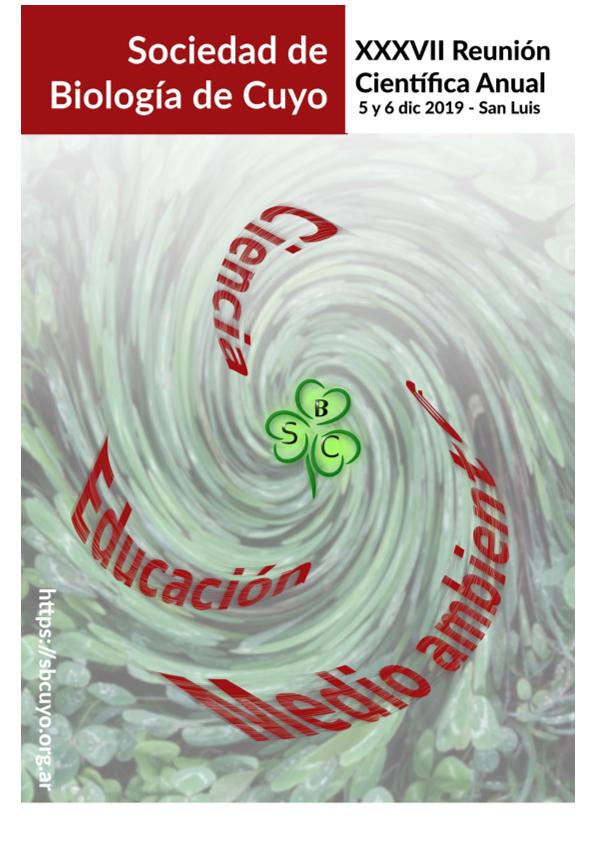Mostrar el registro sencillo del ítem
dc.contributor.author
Dalmazzo, A.
dc.contributor.author
Sycz, Gabriela

dc.contributor.author
Klinke, Sebastian

dc.contributor.author
Damiani, Maria Elena

dc.contributor.author
Otero, Lisandro Horacio

dc.contributor.author
Sanchez, Diego German

dc.contributor.other
Burgos, Mario
dc.contributor.other
Piezzi, Ramon Salvador

dc.date.available
2024-04-19T11:51:10Z
dc.date.issued
2019
dc.identifier.citation
Cloning overexpression and purification of mur enzymes of brucella abortus for structural resolution by x-ray crystallography; XXXVII Reunión Científica Anual Sociedad de Biología de Cuyo; San Luis; Argentina; 2019; 30-31
dc.identifier.uri
http://hdl.handle.net/11336/233532
dc.description.abstract
Peptidoglycan’s biosynthesis is one of the most studied mechanisms in microbiology. It consists of two stages, a cytoplasmic phase dependent on the Mur protein family and a periplasmic phase controlled by the Penicillin Binding Proteins (PBPs) responsible for the formation of the bacterial cell wall. The PBPs have been the target for the search and design of antibacterials since the discovery of penicillin. However, with the increasing acquisition of resistance mechanisms by bacteria, introductio n of novel classes of antibiotics is necessary. On this line, drugs have been clinically incorporated which alter significantly other elements of the biosynthetic machinery as the case of fosfomycin, an inhibitory antibiotic of MurA. This protein, along with the rest of the Mur family, is responsible for synthetizing the UDP-N-acetyl-D-muramate pentapeptide (or UDP-MurNAcpentapéptide), the precursor of peptidoglycan. As Mur enzymes are highly conserved in bacteria and there has not been found a crossed reaction with the eukaryotic cells, it is expected that inhibitors of Mur proteins may be potentially broad spectrum bactericidal compounds. On this work we focus on Mur proteins of Brucella abortus, the etiological agent of Mediterranean Fever, a world-wide distribution zoonosis. We have amplified the MurF gene from B. abortus strain with PCR, cloned inside an expression vector pET28a, expressed and purified to homogeneity by QIAGEN© Ni-NTA affinity resin. Now, we are running crystallization assays in order to solve its 3D structure by X-ray diffraction. This would help to the rational design of new inhibitors against brucellosis.
dc.format
application/pdf
dc.language.iso
eng
dc.publisher
Universidad Nacional de Cuyo

dc.rights
info:eu-repo/semantics/openAccess
dc.rights.uri
https://creativecommons.org/licenses/by-nc-sa/2.5/ar/
dc.subject
BRUCELLA ABORTUS
dc.subject
MUR ENZIMES
dc.subject
3D STRUCTURE
dc.subject
X-RAY CRISTALOGRAPHY
dc.subject.classification
Bioquímica y Biología Molecular

dc.subject.classification
Ciencias Biológicas

dc.subject.classification
CIENCIAS NATURALES Y EXACTAS

dc.title
Cloning overexpression and purification of mur enzymes of brucella abortus for structural resolution by x-ray crystallography
dc.type
info:eu-repo/semantics/publishedVersion
dc.type
info:eu-repo/semantics/conferenceObject
dc.type
info:ar-repo/semantics/documento de conferencia
dc.date.updated
2022-12-12T23:45:19Z
dc.journal.pagination
30-31
dc.journal.pais
Argentina

dc.journal.ciudad
Mendoza
dc.description.fil
Fil: Dalmazzo, A.. Consejo Nacional de Investigaciones Científicas y Técnicas. Centro Científico Tecnológico Conicet - Mendoza. Instituto de Medicina y Biología Experimental de Cuyo; Argentina
dc.description.fil
Fil: Sycz, Gabriela. Consejo Nacional de Investigaciones Científicas y Técnicas. Oficina de Coordinación Administrativa Parque Centenario. Instituto de Investigaciones Bioquímicas de Buenos Aires. Fundación Instituto Leloir. Instituto de Investigaciones Bioquímicas de Buenos Aires; Argentina
dc.description.fil
Fil: Klinke, Sebastian. Consejo Nacional de Investigaciones Científicas y Técnicas. Oficina de Coordinación Administrativa Parque Centenario. Instituto de Investigaciones Bioquímicas de Buenos Aires. Fundación Instituto Leloir. Instituto de Investigaciones Bioquímicas de Buenos Aires; Argentina
dc.description.fil
Fil: Damiani, Maria Elena. Consejo Nacional de Investigaciones Científicas y Técnicas. Centro Científico Tecnológico Conicet - Mendoza. Instituto de Medicina y Biología Experimental de Cuyo; Argentina
dc.description.fil
Fil: Otero, Lisandro Horacio. Consejo Nacional de Investigaciones Científicas y Técnicas. Oficina de Coordinación Administrativa Parque Centenario. Instituto de Investigaciones Bioquímicas de Buenos Aires. Fundación Instituto Leloir. Instituto de Investigaciones Bioquímicas de Buenos Aires; Argentina
dc.description.fil
Fil: Sanchez, Diego German. Consejo Nacional de Investigaciones Científicas y Técnicas. Centro Científico Tecnológico Conicet - Mendoza. Instituto de Medicina y Biología Experimental de Cuyo; Argentina
dc.relation.alternativeid
info:eu-repo/semantics/altIdentifier/url/https://sbcuyo.org.ar/wp-content/uploads/2019/12/Libro-de-resumenes-2019.pdf
dc.conicet.rol
Autor

dc.conicet.rol
Autor

dc.conicet.rol
Autor

dc.conicet.rol
Autor

dc.conicet.rol
Autor

dc.conicet.rol
Autor

dc.coverage
Nacional
dc.type.subtype
Reunión
dc.description.nombreEvento
XXXVII Reunión Científica Anual Sociedad de Biología de Cuyo
dc.date.evento
2019-12-05
dc.description.ciudadEvento
San Luis
dc.description.paisEvento
Argentina

dc.type.publicacion
Book
dc.description.institucionOrganizadora
Sociedad de Biología de Cuyo
dc.source.libro
Libro de Resúmenes de la XXXVII Reunión Científica Anual Sociedad de Biología de Cuyo
dc.date.eventoHasta
2019-12-06
dc.type
Reunión
Archivos asociados
